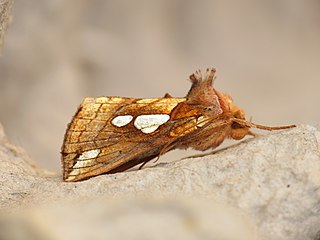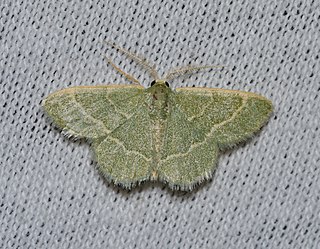
Moths are a group of insects that includes all members of the order Lepidoptera that are not butterflies. They were previously classified as suborder Heterocera, but the group is paraphyletic with respect to butterflies and neither subordinate taxon is used in modern classifications. Moths make up the vast majority of the order. There are approximately 160,000 species of moth, many of which have yet to be described. Most species of moth are nocturnal, although there are also crepuscular and diurnal species.

Prunus virginiana, commonly called bitter-berry, chokecherry, Virginia bird cherry, and western chokecherry, is a species of bird cherry native to North America.

Hemaris diffinis, the snowberry clearwing, is a moth of the family Sphingidae. This moth is sometimes called "hummingbird moth" or "flying lobster". This moth should not be confused with the hummingbird hawk-moth of Europe.

Eupoecilia ambiguella, the vine moth or European grape berry moth, is a Palearctic moth species of the family Tortricidae. It was first described in 1796 by Jacob Hübner. It is an economically significant grape pest species.

Duponchelia fovealis is a species of moth of the family Crambidae described by Philipp Christoph Zeller in 1847. It is endemic to the area surrounding the Mediterranean Sea, and the Canary Islands, but has extended its range to other parts of Africa, Europe, the Middle East and North America.

Anaea aidea, the tropical leafwing, is a species of brush-footed butterfly in the subfamily Charaxinae. Its native range extends from Mexico to northwestern Costa Rica, with strays sometimes seen in southern Texas, Arizona, and California in the United States. Some authors consider Anaea aidea to be a subspecies of Anaea troglodyta.

Lophocampa argentata, the silver-spotted tiger moth, is a species of moth in the family Erebidae. It was described by Packard in 1864. It is found from British Columbia to southern California, and east to Arizona, Nevada, New Mexico, Colorado, Utah, Wyoming and possibly to northern Mexico.

Catocala ilia, the Ilia underwing, beloved underwing or wife underwing, is a moth of the family Erebidae. The species was first described by Pieter Cramer in 1776. It can be found in the eastern part of the United States as well as southern Canada. Subspecies Catocala ilia zoe can be found in California and Arizona.

Macaria signaria, the dusky peacock, pale-marked angle or spruce-fir looper, is a moth of the family Geometridae. The species was first described by Jacob Hübner in 1809. Subspecies Semiothisa signaria signaria is found in Europe, Turkey, the Caucasus, Transcaucasia, the Ural, Siberia, Far East, Sakhalin, northern Iran and Japan. Subspecies Macaria signaria dispuncta is found in North America.

Lobocleta is a genus of moths in the family Geometridae erected by Warren in 1906.

Plusia putnami, the Lempke's gold spot or Putnam's looper moth, is a species of moth of the family Noctuidae. It is found in the Palearctic realm, from Japan and eastern Siberia to Fennoscandia, Great Britain, and France. In North America, it ranges from Newfoundland and Labrador to central Alaska and the interior of British Columbia, south to Pennsylvania, Washington, north-eastern California, and in the Rocky Mountains to Utah and Colorado.

Drasteria grandirena, the figure-seven moth or great kidney, is a moth of the family Erebidae first described by Adrian Hardy Haworth in 1809. It is found in North America from Ontario, Quebec and Nova Scotia, south to at least Georgia west to at least Arkansas

The Erebidae are a family of moths in the superfamily Noctuoidea. The family is among the largest families of moths by species count and contains a wide variety of well-known macromoth groups. The family includes the underwings (Catocala); litter moths (Herminiinae); tiger, lichen, and wasp moths (Arctiinae); tussock moths (Lymantriinae), including the arctic woolly bear moth ; fruit-piercing moths ; micronoctuoid moths (Micronoctuini); snout moths (Hypeninae); and zales, though many of these common names can also refer to moths outside the Erebidae. Some of the erebid moths are called owlets.

Parapediasia teterrellus, the bluegrass webworm moth, bluegrass webworm, bluegrass sod webworm moth or bluegrass sod webworm, is a moth of the family Crambidae.

Phoebis agarithe, the large orange sulphur, is a butterfly in the family Pieridae. It is found from Peru north to southern Texas and peninsular Florida. Rare strays can be found up to Colorado, South Dakota, Wisconsin, and New Jersey. The species has also been introduced in Hawaii. The habitat consists of open, tropical lowlands including gardens, pastures, road edges, trails and parks.

Chionodes mediofuscella, the black-smudged chionodes moth, is a moth of the family Gelechiidae. It is found in North America, where it has been recorded from Nova Scotia to Florida and from British Columbia to Colorado, Arizona and northern California.

Chlorochlamys phyllinaria, the thin-lined chlorochlamys moth, is a moth of the family Geometridae. It is found in North America, where it has been recorded from Georgia to California, northward in the central states to Nebraska.

Lobocleta peralbata is a moth in the family Geometridae. It is found in North America, where it has been recorded from Arizona to Florida, north to North Carolina.
Lobocleta plemyraria, the straight-lined wave, is a species of geometrid moth in the family Geometridae. It is found in North America.
Lobocleta griseata is a species of geometrid moth in the family Geometridae. It is found in North America.

















